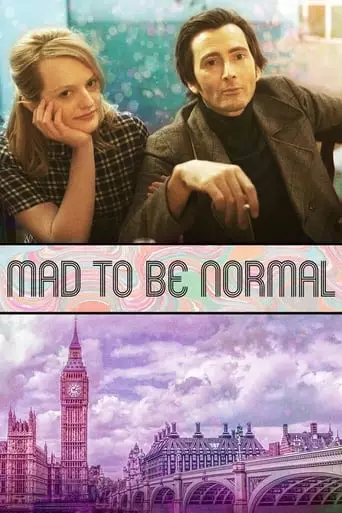The story of Scottish psychiatrist RD Laing and his unique community at Kingsley Hall, East London in the 1960s.
Mad to Be Normal is a biographical drama centered on the controversial Scottish psychiatrist R.D. Laing (played by David Tennant). The film is set during Laing’s years at Kingsley Hall in London, where he pioneered an alternative approach to treating schizophrenia and other mental disorders. Laing’s methods focused on understanding and addressing the social and psychological contexts that contributed to mental illness, rather than using medication or traditional psychiatric practices. The film explores Laing’s relationships with his patients, colleagues, and family, shedding light on his unconventional views and often chaotic personal life.
The narrative follows Laing’s struggles with maintaining his ideals while confronting his personal flaws, including his alcohol abuse and the limitations of his therapeutic practices. His program at Kingsley Hall, which encouraged patients to live with doctors in a more egalitarian environment, is shown in stark contrast to the more conventional psychiatric hospitals of the time. The film also delves into the personal toll that Laing’s methods and lifestyle took on those around him.
Themes of Mad to Be Normal
Several key themes are explored in Mad to Be Normal, making it a thought-provoking film for those interested in psychology, psychiatry, and the human condition:
- Mental Health and Society: The film challenges traditional views of mental illness, particularly the idea that conditions like schizophrenia are solely biological. Laing believed that psychosis was a response to societal dysfunction, particularly the family dynamics that often led to psychological distress. This theme critiques the broader societal understanding of mental health, positioning mental illness as a rational response to an irrational world.
- The Ethics of Treatment: Laing’s unorthodox methods raise ethical questions about psychiatric care. His refusal to use medication and his promotion of a more humane, understanding approach to psychosis highlight the ethical dilemmas in psychiatric treatment. The film raises important questions about the balance between compassion and control in the treatment of mental health issues.
- The Person vs. the System: The film explores Laing’s ongoing tension between individual freedom and societal expectations. His work challenges institutional norms, questioning whether the system is truly equipped to understand or help individuals struggling with mental illness. It also shows how Laing’s own struggles with addiction and personal demons complicated his ability to fully achieve his therapeutic goals.
- Personal and Professional Struggles: Laing’s life was marked by personal and professional turbulence. The film doesn’t just focus on his work with patients but also looks at his relationship with his family and colleagues. This dynamic illustrates the complexities of Laing’s character—his genius was often intertwined with his destructive tendencies.
10 Reasons to Watch Mad to Be Normal
- David Tennant’s Stellar Performance: Tennant brings depth and nuance to his portrayal of R.D. Laing. His interpretation of the psychiatrist captures both his brilliance and his flaws, making Laing a compelling character.
- Unique Perspective on Psychiatry: The film offers a rare, thought-provoking look at a psychiatrist who challenged conventional treatments and believed that mental illness had deeper social and psychological roots.
- Historical Significance: Mad to Be Normal provides insight into an important chapter in the history of psychiatry, offering a historical perspective on how mental illness was treated in the mid-20th century.
- The Human Side of Psychiatry: The film focuses not only on Laing’s professional work but also on his personal life, showing how his theories impacted those closest to him, including his patients and family.
- Complex Characters: Beyond Laing, the film features rich performances from supporting characters, such as his patients and colleagues, providing a deeper understanding of the emotional and psychological toll of living within psychiatric systems.
- Psychological Insights: The film serves as a meditation on the nature of mental illness, offering a rare opportunity to reflect on the human experience of psychosis and its relationship to society.
- Powerful Cinematic Scenes: Some scenes, such as Laing’s interaction with a mute patient, highlight the film’s emotional depth and showcase the power of non-traditional approaches to mental health treatment.
- Strong Supporting Cast: Alongside Tennant, the film features strong performances by Michael Gambon and Gabriel Byrne, adding weight to the story.
- The Film’s Ambiguity: The open-ended nature of the film, with its lack of traditional closure, invites reflection on the complexities of Laing’s methods and the lasting impact of his work.
- A Cinematic Journey into the Mind: For those interested in understanding how radical ideas about mental health are tested in practice, Mad to Be Normal is an intriguing and enriching watch.
How You’ll Feel After Watching Mad to Be Normal
Watching Mad to Be Normal is an emotionally complex experience. The film is not designed to be a feel-good story, as it challenges viewers to reconsider traditional ideas about mental health and treatment. You might feel a mix of admiration for Laing’s bravery in questioning the psychiatric establishment, as well as frustration with his personal contradictions. The movie’s introspective nature may leave you thinking deeply about the limits of mental health care, the ethical dilemmas faced by psychiatrists, and the personal cost of challenging societal norms. Ultimately, it’s a film that encourages reflection on the human mind, both in terms of its potential for creativity and its vulnerabilities.
The film’s ambiguity and open-ended approach might leave you pondering the true effectiveness of Laing’s methods, while also grappling with the ethical and personal questions it raises. It’s a film that invites both admiration and critique, leading to a thought-provoking post-viewing experience.
Mad to Be Normal is a rare and challenging film, offering a nuanced and complex portrait of one of the most unconventional figures in psychiatry.

